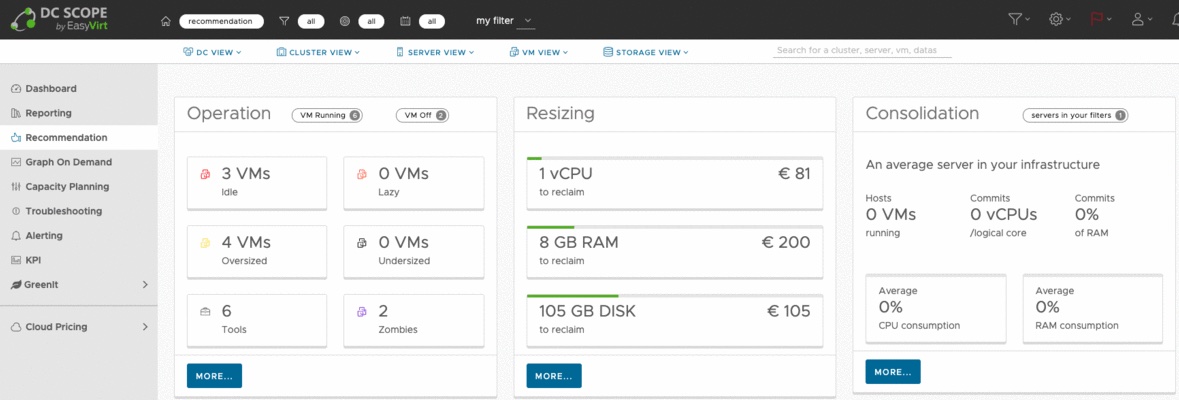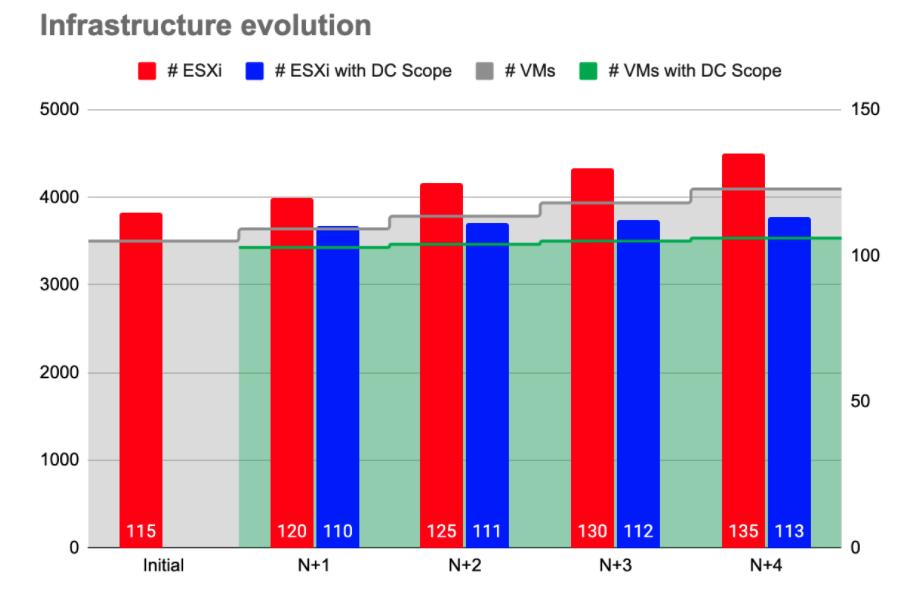vRealize (vRops), Turbonomic, Veeam One, and DC Scope are common solutions for the management of vSphere infrastructures. They all provide multiple benefits for CTO’s and system administrators as the centralization of the information concerning the elements in the infrastructure, the rates for resource consumption, and more. In most cases, they also provide recommendations for correct sizing of virtual machines, troubleshooting, and multiple functionalities to control the infrastructure.
Despite all these solutions provide similar information and functionalities, there are substantial differences in the approach they used to collect and store the data of the infrastructure, the final problem they are looking to answer, and the main functionalities they offer. As an example, you have vRealize which is more suitable for the automation of large infrastructures (more than 15.000 virtual machines), VeeamOne for backup supervision, and DC Scope for management, administration, optimization perspective of the vSphere infrastructure.
Each one of these solutions offers a different path to calculate their Return On Investment (ROI). With this short article, we would like to explore the ROI that DC Scope can provide to your infrastructure.
ROI in infrastructure
The ROI in infrastructure provided by DC Scope starts just a few days after its installation. It is focused on the reduction of virtual machines running in the infrastructure and the reduction of the number of servers used to support workloads in the infrastructure. Bear in mind that the reduction of servers in use is automatically translated into less money spent on software licenses, services, and power consumption.
Once deployed (15 minutes or less), DC Scope collects and stores granular metrics of the infrastructure. It keeps and analyzes this data daily to define the status of virtual machines, optimizations opportunities, issues in the virtual machines and servers, alerts, and more.
After a few days of data collection, DC Scope provides the list of virtual machines in:
- Idle status: virtual machines that are not being used and that could be deleted.
- Oversized status: virtual machines that are not using the allocated resources and that could be resized to be adapted to the real consumption.
- Zombie status: disk storage associated with inexistent virtual machines.


Additionally, DC Scope will provide you with recommendations for the consolidation of servers and allows you to simulate the reduction of servers in each cluster/datacenter. You can even simulate the consolidation limit for your whole infrastructure.
These recommendations for virtual machines and servers are processed daily so they include all new virtual machines and servers you have added to the infrastructure, which assure a constant ROI of the solution even after several years of installation.
ROI Calculator
Estimate and analyze your Return on Investment (ROI) with our calculator ROI.
Click here!
We at EasyVirt have analyzed the performance of more than 2000 infrastructures in different organizations (public administrations, private infrastructures, host providers, etc.) using DC Scope, and we have noticed optimization rates of:
7% of virtual machines reduction after 6 months of use of DC Scope. This reduction is linked to the deletion of unused virtual machines, deletion of virtual machines zombies, and an initial resizing of oversized virtual machines.
5% of virtual machine reduction every year. This reduction is linked to the constant recommendations in terms of sizing and cleaning that DC Scope offers to new and existing virtual machines.
25% of additional virtual machines in each ESXi. This percentage is linked to the use of the capacity planning and consolidation module to increase the ratio of virtual machines per ESXi.
Let’s see an example:
An infrastructure with 3500 virtual machines (VMS) and 115 ESXi is expected to have an annual increase of 4% in the number of virtual machines each year over the next 4 years.
Without the management of DC Scope, the infrastructure is expected to add 600 additional virtual machines over the 4 years. Keeping the ratio of 30 VMS/ESXi of the initial year, the infrastructure will need 20 additional ESXi to support the new workloads. That means adding the cost of licenses, maintenance, power, etc. to at least 20 additional ESXi.


Adding a low initial optimization of 6%, an annual optimization of 4%, and a low increase in the consolidation rate of ESXi of only 3% (bear in mind that according to our clients, the increase of virtual machines in servers is usually around 25%), we can see that DC Scope can reduce drastically the number of virtual machines and remove the need of adding additional ESXi to the infrastructure. In this particular example, at the end of the 4 years the infrastructure will have 35 additional virtual machines (3535 in total) and could be supporting this workload load with 113 servers (2 servers less than initially).
This short example shows how having DC Scope in your infrastructure can provide a fast ROI by optimizing virtual machines and reducing the number of virtual machines and physical servers. But this is not all, as there are also gains in time and productivity that we will cover in future articles.

